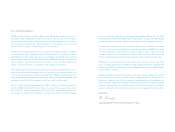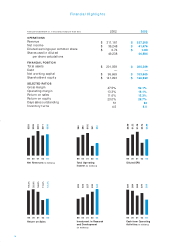Plantronics 2003 Annual Report Download - page 18
Download and view the complete annual report
Please find page 18 of the 2003 Plantronics annual report below. You can navigate through the pages in the report by either clicking on the pages listed below, or by using the keyword search tool below to find specific information within the annual report.
29
Inventory. Inventory is stated at the lower of cost or market. Cost is computed using standard
cost, which approximates actual cost on a first-in, first-out basis. We periodically review for
excess and obsolete inventories and reduce carrying amounts to estimated net realizable value.
Depreciation and Amortization. Property and equipment are stated at cost less
accumulated depreciation and amortization. Depreciation and amortization are principally
calculated using the straight-line method over the estimated useful lives of the respective
assets. In accordance with our adoption of SFAS No. 142, “Goodwill and Other Intangible
Assets,” goodwill is not amortized, for periods subsequent to April 1, 2001, but is tested
annually for impairment, or more often as deemed necessary. Identified intangible assets are
amortized over their estimated economic lives, which range from three to seven years.
Depreciation expense for fiscal 2001, 2002, and 2003 was $8.9 million, $8.9 million and $10.6
million, respectively.
Revenue Recognition. Revenue is recognized net of estimated product returns,
exchanges, credits for price protection, volume rebates, and sales incentive credits given to
customers in excess of the fair value of benefits received. Revenue from sales is recognized
when a purchase order has been received, the product has been shipped, title has transferred
to the customer, the sales price is fixed or determinable and collection of the resulting
receivable is probable. We also provide for the estimated cost of repair or replacement
products under warranty at the time of sale.
Research and Development Costs. Research and development costs are charged to
operations as incurred.
Advertising Costs. We expense all advertising costs as incurred. Advertising expense for
the years ended March 31, 2001, 2002 and 2003 was $6.7 million, $2.5 million, and $3.4
million, respectively.
Concentration of Credit Risk. Financial instruments that potentially subject Plantronics
to concentrations of credit risk consist principally of cash equivalents, marketable securities
and trade receivables. Our cash investment policies limit investments to those that are short-
term and low risk. Our cash investment policies also limit the amount of credit exposure to any
one issuer and restrict placement of these investments to issuers evaluated as creditworthy.
Cash equivalents have an original or remaining maturity when purchased of 90 days or less;
marketable securities have an original or remaining maturity when purchased of greater than
90 days, but less than one year. Concentrations of credit risk with respect to trade receivables
are generally limited due to the large number of customers that comprise our customer base,
and their dispersion across different geographies and markets. We perform ongoing credit
evaluations of our customers’ financial condition and generally require no collateral from our
customers. We maintain an allowance for uncollectible accounts receivable based upon
expected collectibility of all accounts receivable.
Fair Values of Financial Instruments. The carrying values of our financial instruments,
including cash, cash equivalents, marketable securities, accounts receivable, accrued expenses
and liabilities, approximate fair value due to their short maturities.
28
Notes to Consolidated Financial Statements
NOTE 1. THE COMPANY
Plantronics introduced the first lightweight communications headset in 1962. Since that time,
we have become a worldwide leading designer, manufacturer and marketer of lightweight
communications headset products.
NOTE 2. SUMMARY OF SIGNIFICANT ACCOUNTING POLICIES
Management’s Use of Estimates and Assumptions. The preparation of financial
statements in accordance with generally accepted accounting principles in the United States
of America requires management to make estimates and assumptions that affect the reported
amounts of assets and liabilities and disclosures of contingent assets and liabilities at the date
of the financial statements and the reported amounts of sales and expenses during the
reporting period. Actual results could differ from those estimates.
Principals of Consolidation. The consolidated financial statements include the accounts
of Plantronics and its subsidiary companies. Intercompany transactions and balances have
been eliminated upon consolidation.
Fiscal Year. Our fiscal year end is the Saturday closest to March 31. For purposes of
presentation, we have indicated our accounting year ended on March 31. Results of operations
for the fiscal years 2001, 2002 and 2003 all included 52 weeks.
Cash, Cash Equivalents, and Marketable Securities. We consider all highly liquid
investments with an original or remaining maturity of 90 days or less at the date of purchase
to be cash equivalents. Investments maturing between 3 and 12 months from the date of
purchase are classified as marketable securities.
Management determines the appropriate classification of investment securities at the time of
purchase and re-evaluates that designation as of each balance sheet date. As of March 31, 2003,
investment securities were classified as held-to-maturity, as we intended, and had the ability
to hold these securities to maturity. Held-to-maturity securities are stated at amortized cost,
which approximates fair market value.
The estimated fair values of cash equivalents and marketable securities are based on quoted
market prices. As of March 31, 2002 and 2003, we had $17.3 million and $5.0 million in
marketable securities, respectively, which consisted of corporate and government bonds, were
classified as held-to-maturity, and had maturities of less than one year. As of the dates below,
our cash and cash equivalents consisted of the following:
March 31,
(in thousands) 2002 2003
Cash $7,511 $31,727
Cash equivalents 35,537 22,977
Cash and cash equivalents $43,048 $54,704
























